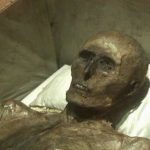 Weird Stuff
Weird Stuff  Weird Stuff
Weird Stuff  Mysteries
Mysteries 10 Tragic Disappearances and Deaths in Joshua Tree National Park
 History
History 10 Ways Childhood Really Sucked in the Old West
 Music
Music 10 Name Origins of Famous Bands from the 1990s
 Religion
Religion 10 Biggest Turnarounds by the Catholic Church
 Weird Stuff
Weird Stuff 10 Unbelievable Times Laws Had Unintended Consequences
 Humans
Humans Ten Historic Women Who Deserve Way More Credit Than They Got
 Movies and TV
Movies and TV 10 Films That Spawned Major Lawsuits
 History
History Ten Times Towns Were Wiped Off the Face of the Earth
 Creepy
Creepy 10 of the Most Disturbingly Haunted Public Houses in the UK
 Weird Stuff
Weird Stuff 10 Niche Subcultures That Are More Popular Than You Might Think
 Mysteries
Mysteries 10 Tragic Disappearances and Deaths in Joshua Tree National Park
 History
History 10 Ways Childhood Really Sucked in the Old West
Who's Behind Listverse?

Jamie Frater
Head Editor
Jamie founded Listverse due to an insatiable desire to share fascinating, obscure, and bizarre facts. He has been a guest speaker on numerous national radio and television stations and is a five time published author.
More About Us Music
Music 10 Name Origins of Famous Bands from the 1990s
 Religion
Religion 10 Biggest Turnarounds by the Catholic Church
 Weird Stuff
Weird Stuff 10 Unbelievable Times Laws Had Unintended Consequences
 Humans
Humans Ten Historic Women Who Deserve Way More Credit Than They Got
 Movies and TV
Movies and TV 10 Films That Spawned Major Lawsuits
 History
History Ten Times Towns Were Wiped Off the Face of the Earth
 Creepy
Creepy 10 of the Most Disturbingly Haunted Public Houses in the UK
10 Strange Adventures of Famous Historic Corpses
Many graves have the message “Rest in Peace” carved on them. For most of us, this will probably come true as our dead bodies are unlikely to be disturbed before they have rotted to nothing. For famous people, however, there is a long history of their bodies being dug up, desecrated, or generally mishandled. Even death cannot rob some people of their allure, it seems.
Here are ten times famous people had strange things happen after their deaths.
Related: Top 10 Modern Cases Of Corpse Theft
10 Jeremy Bentham
Jeremy Bentham was one of the most influential philosophers of the early 19th century in England. He was one of the founders of Utilitarianism and suggested that “it is the greatest happiness of the greatest number that is the measure of right and wrong.” As well as being a social reformer, Bentham also thought there were ways to get some utility out of dead bodies, specifically his own.
Bentham said that it was a waste of time to carve statues of great people when their corpses could be preserved and put on display. He called these cadavers “auto-icons,” and when his own death came in 1832, he left his body to a friend who was to undertake the process. It is said that for years before his death, Bentham carried around the glass eyes that were to be set into his head.
Unfortunately, something went wrong with the preservation, and Bentham’s head ended up looking like a deflated brown leather soccer ball. A wax head was substituted for the real one. The real head was occasionally stolen by naughty students and ransomed back to the University authorities. Bentham’s body can still be viewed today at University College in London. Rumors that he is wheeled into meetings of the university council and recorded at “present but not voting” are regrettably untrue.[1]
9 The Cadaver Synod
The worst that most popes face after their death is that they will not be declared a saint. But being elected to head the Catholic Church has sometimes been a risky business. Rival candidates were always ready to denounce your actions, and if you upset a king, they might invade Rome. Even once you died, your trials were not necessarily over.
The 9th-century pope Formosus made the mistake of siding with one Italian power against another. After Formosus had been dead for seven months, his corpse was exhumed and placed on trial by his successor, Stephen VI. Known as the Cadaver Synod, this trial saw the dead pope dressed in his regalia, propped up on a throne, and charged with numerous crimes. When an earthquake struck the court during the proceedings, some took it as a sign of God’s displeasure at this post-mortem trial, but the synod continued.
Formosus was found guilty and declared to have illegally stolen the papacy. He was stripped of his papal robes, the fingers he had used to give blessings were struck off, and he was tossed into the Tiber. Stephen VI did not long survive his triumph. The allies of Formosus retook control of Rome, and Stephen was hauled away to prison, where he was quietly strangled to death.[2]
8 Oliver Cromwell
The saying that goes, “if you come for the king, you better not miss,” should have a warning attached to it. Even if you manage to kill and replace the king, you are still in danger. In the brutal English civil war of the 17th century, Oliver Cromwell was instrumental in the victory of the parliamentary forces and the execution of king Charles I.
Cromwell was eventually named Lord Protector of England, a king in all but name. Once Cromwell died, when most English people were tired of dreary Puritan rule, the dead king’s son Charles was invited to take back the empty throne. Charles II was in a forgiving mood, except when it came to those who had killed his father.
Charles II ordered the execution of all the regicides. It did not matter that several of them had already died by this point. Cromwell’s corpse was dug up and executed anyway. Samuel Sainthill witnessed the execution and recorded how Cromwell was very well preserved. Regardless, his head was cut off, and Sainthill handled some of Cromwell’s toes that had been cut off by apprentice boys. It took eight blows of the ax to cleave Cromwell’s head from his body.
The king killer’s head was mounted on a spike outside Westminster Hall for 20 years before it was blown down in a storm. It was then stolen and passed between collectors until 1960, when it was buried in an unmarked grave inside Cambridge College, where Cromwell had once studied.[3]
7 Inês de Castro
Inês de Castro was descended from Spanish nobility, though born of an illicit union between a noble and his mistress. Despite this, she was appointed to serve Constance of Castile when she married Peter, heir to the throne of Portugal, in 1340. Peter fell madly in love with Inês instead of his lawful wife, however. When Constance died, he refused to marry again unless it was to Inês. Together the pair had several illegitimate children. The king of Portugal soon tired of his son’s politically embarrassing infatuation and had Inês decapitated on his orders.
When Peter became king after the death of his father, he declared that he and Inês de Castro had actually been married and, therefore, she was the rightful queen of Portugal. Indeed Peter built royal tombs so that the two could be buried together in all the pomp of a king and queen and had Inês’s corpse exhumed for reburial. But another story is told about Peter’s obsession with his dead lover.
According to later tales, Peter had Inês dug up and dressed her corpse like a queen. He had her placed on a throne and set a crown on her head, which must have been reattached for the event. Then every noble of the court was forced to kiss the corpse’s hand and swear loyalty to their new queen.[4]
6 Eva Peron
Having a musical written about her by Andrew Lloyd Webber was not the worst indignity that Eva Peron, the famed first lady of Argentina, had to face after her death. Along with her husband, president Juan Peron, she helped to run the Argentinian government and was hugely popular with the working-class people.
By 1952 however, Eva Peron was seriously ill with cervical cancer and died at only 33. Three million people attended her funeral, but this did not end with her body being buried. Instead, a vast statue was planned, larger than the Statue of Liberty, and she was to be entombed in the base. While this was being built, her embalmed body was left on display for two years.
When Juan Peron was ousted from office in 1955 by a military coup, he was forced to flee the country—and Eva’s body was left behind. The new government banned Peronists, so the question arose about what to do with Eva’s body. Military officers were told to hide the corpse, but wherever it went, flowers and candles were placed nearby. With the help of the Vatican, the body was smuggled to Rome under a false name.
In 1971, it was decided that the body could be returned to Juan, who was living in exile in Spain. When he received the corpse, he lay her on a table and, with help from his new wife, cleaned the body with cotton pads. It was fairly well preserved. When Peron returned to Argentina to become president in 1973, the body went with him. He died just one year later, and a grand tomb for the pair was planned. Unfortunately, it was not to be, as another military coup took place.
Today, Eva rests in a strong tomb with her family that—hopefully—means her post-mortem wanderings are at an end.[5]
5 Einstein’s Brain
Sometimes it is not the whole body of a famous person who goes on an adventure after their death. Sometimes it is just a piece that is carried off. When you have the world’s most renowned scientist, what part would you steal? The answer for pathologist Dr. Thomas Harvey, who performed Albert Einstein’s autopsy in 1955, was obvious—he extracted Einstein’s brain. Surely, by studying this historically important brain, the reason he had been so fruitful could be revealed?
When a journalist went in search of the brain in 1978, he tracked down Harvey, who was unwilling to discuss the missing organ. Harvey had cut the brain into little sections, hoping that he could collaborate with other scientists on deciphering the mysteries of Einstein’s mind. Alas, this had not happened, and when the reporter asked to see pictures of the brain, Harvey revealed that it was being kept in a beer cooler and showed the remains to him.
After the publication of the article revealing the location of Einstein’s brain, several researchers did examine it. Several minor abnormalities in the structure and density of brain cells were found, but nothing that can fully explain why genius once resided in this greyish mass of flesh.
The brain is now only allowed to be accessed by serious scientists, with somewhat more care than it had formerly been shown. When the BBC visited Harvey in 1994, they recorded him picking a bit of the brain out of its jar with a fork and onto a cheeseboard before slicing some off with a kitchen knife.[6]
4 Charlie Chaplin
Charlie Chaplin came from a family so poor that several times he was placed into grim Victorian workhouses. From this unpromising beginning, he rose to become one of the world’s most famous and wealthy stars. His career spanned 70 years, and when he died in 1977, he might have expected a well-earned rest. Unfortunately, his fame followed him to his grave.
Just months later, Chaplin’s body was stolen from its grave in Switzerland. Chaplin’s widow then received a phone call demanding hundreds of thousands of dollars for the return of the corpse. She refused and alerted the police. The ransomers then threatened her children. Luckily, the police soon tracked down Roman Wardas and Gantscho Ganev. The pair had decided that grave robbing was the best bet for easing their financial woes. They pointed the police toward a nearby cornfield where they had hidden the body.
Chaplin was returned to his resting place—with a new concrete layer to dissuade others from making a quick buck with the former star.[7]
3 Alexander the Great
Alexander the Great conquered the largest empire the world had ever seen in the 4th century BC. However, his military glory could not spare him from an early death at just 32. Alexander left no clear successor as his son was too young to rule alone. Instead, his generals, known as the Diadochi, began to fight over who should rule which part of the empire. One of the first battles was over who should have Alexander’s body.
Alexander had died in Persia, but it was thought the body should be returned to Macedon to be buried with his ancestors. Ptolemy, who had claimed Egypt, had other ideas, however. Ptolemy stole the body while it was being moved and took it to Memphis. Whoever held the body of Alexander could claim legitimacy for their rule. According to ancient sources, it had also been prophesied that whoever had the body would be unconquerable.
For centuries the body of Alexander was displayed in Alexandria in Egypt. Julius Caesar and later Roman emperors liked to visit the tomb and see the body.[8]
2 Catherine of Valois
Catherine of Valois was the daughter of the French king and wife to Henry V of England in the 15th century. When she died, she was buried with pomp in Westminster Abbey. Today, you can still view the wooden effigy of the queen that was placed on her coffin during the funeral. However, for a long time, you could see the actual queen herself. And sometimes do a bit more… if you wanted.
When her tomb was altered under Henry VII, the lid was dislodged, and tourists would come to examine her body. In 1699, the diarist Samuel Pepys paid her a visit and recorded the event.
“Here we did see, by particular favour, the body of Queen Katherine of Valois; and I had the upper part of her body in my hands, and I did kiss her mouth, reflecting upon it that I did kiss a Queen, and that this was my birth-day, thirty-six years old, that I did first kiss a Queen.”
Queen Catherine was reburied properly when Queen Victoria was on the throne.[9]
1 Philip the Handsome
Philip I of Castile was known by his contemporaries as Philip the Handsome. With a nickname like that, you might imagine he was a hit with the ladies. One lady was indeed obsessed with him. Philip had married Joanna, heiress to the Spanish crowns, in 1496, and she loved him madly. This is not unexpected as history remembers her as Joanna the Mad.
The marriage was not a happy one. Though Joanna deeply loved Philip, he continued to have affairs that drove Joanna into a rage. He also kept trying to steal power from her. Many historians believe that Joanna was not truly insane but just deeply depressed by the situation she was in. Rumors of her madness would have benefited Philip in his attempts to usurp her rights.
When Philip died suddenly, Joanna said he had been poisoned. She refused to allow his body to be buried where he had died and had it taken on a lengthy journey of over 400 miles. Along the way, she would have the coffin opened so that she could embrace her dead husband.
Unsurprisingly this sort of action did not help the rumors of madness surrounding her. She was eventually placed in a convent, and the rule of the Spanish kingdoms passed to her son Charles.[10]





![Top 10 Haunting Images Of Historic Tragedies [DISTURBING] Top 10 Haunting Images Of Historic Tragedies [DISTURBING]](https://listverse.com/wp-content/uploads/2020/05/33758v-150x150.jpg)


